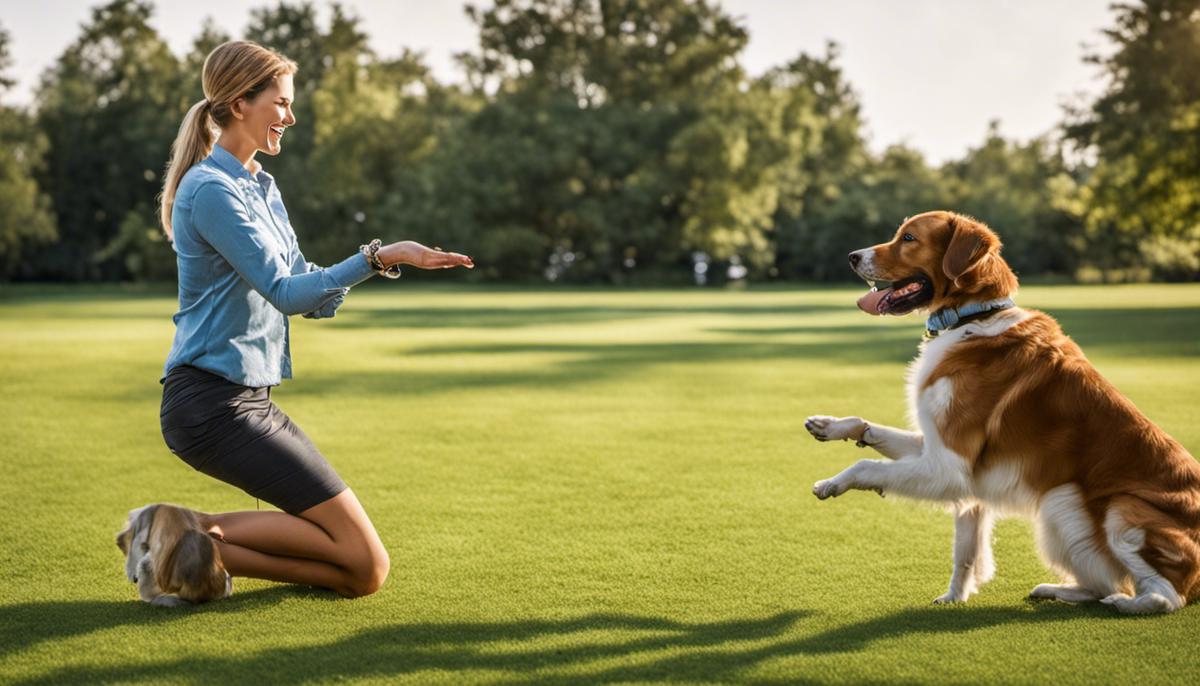Anyone fortunate enough to own a dog knows well how this loving, loyal creature can quickly become an integral component of the family unit. This is why effective communication with your canine friend is crucial, and learning to understand each other’s signals can enhance your relationship significantly. This involves mastering basic dog training techniques especially reward-based ones like clicker and verbal command training. Furthermore, recognizing dog communication signals and discerning between regular behavior and actual hunger has paramount importance. Teaching your dog to request food through specific signals such as sitting or bell touching with consistent repetition and positive reinforcement, can streamline your feeding regime and reduce any confusion.
Understanding Basic Dog Training
Understanding Basic Principles of Dog Training
Training a dog to ask for food involves understanding their basic behavioral patterns and responses. Dog training is largely based on positive reinforcement, where good behavior is rewarded and negative behavior is ignored or corrected. Rewards can range from simple verbal praise to food and toys. Dogs seek to please their owners, and rewarding good behavior encourages them to repeat that behavior.
Methods of Reward-Based Training
A common method of reward-based training involves using clickers. Known as clicker training, this method uses a small device that makes a distinctive click sound to signal to the animal that they have performed the desired action. The click is immediately followed by a reward, conditioning the dog to associate the sound with a positive response.
Implementing verbal commands is another aspect of dog training. Be consistent with your words, and limit commands to one or two syllables. Use a firm but cheerful voice to convey commands. Remember, dogs do not understand the language but respond to the sound and tone of your voice.
Lastly, consider using hand signals along with verbal commands. Many dogs respond well to visual cues and they can be a useful tool when training your dog to ask for food.
Training Your Dog to Ask for Food
Start by choosing a specific gesture or action that your dog will use to ask for food. This could be the dog sitting by their food bowl, ringing a bell, or giving you a particular look. Model this behavior for your dog and reward them with a treat when they mimic the behavior.
For clicker training, immediately click the clicker and reward your dog every time they ask for food using the chosen gesture or action. This will signal your dog that they’ve performed the desired behavior and train them to repeat it. Also, when your dog performs the action without being asked, ensure to reinforce it with a click and a reward.
For verbal command training, teach your dog a command like “food” or “eat” that you will use to signal mealtime. Say the command every time you feed your dog, so they associate the word with their food. Eventually, your dog will learn to respond to the command and even approach you when they hear it, signaling they want to eat.
Remember, patience and consistency are key factors in successful dog training. It may take time and repetition for your dog to understand and respond consistently to the chosen command or cue. And always end the training sessions on a positive note to keep the experience enjoyable for your dog.

Dog’s Communication Signals
Understanding Dog Signals
The first step is to understand the signals your dog commonly uses to communicate their needs. Dogs primarily rely on body language, which can include anything from the position of their ears and tail, to their posture and facial expressions. Every dog is unique, but there are common signals you can look out for.
A relaxed dog, for instance, will often have a loosely wagging tail and relaxed eyes. Their body won’t appear tense or tightened. If your dog seems excited or anxious, they might exhibit behaviors like wagging their tail rapidly, yipping, jumping, or moving with short, quick movements.
Recognizing Hunger Signals
Without the ability to verbally express themselves, dogs have to rely on these body signals to convey their hunger. These hunger signals can differ from dog to dog but again, there are some common signs shared by most dogs.
Typically, if your dog is hungry, they might hover around where their food is usually kept or around you when you’re in the kitchen. They may even start pawing at the cabinets or the fridge. Some dogs take a more direct route and nudge their food bowl or stand near it longingly. Dogs may also become more alert, wag their tails more often, or engage in more attention-seeking behaviors.
If your dog is behaving unusually or intensely focused on food, consider if they might be hungry. However, be aware of the possibility of overfeeding. Dogs love food and will often behave as if they’re hungry even when they’re not. A good understanding of your dog’s average food consumption and feeding schedule can help you discern their genuine hunger signals.
Teaching Your Dog to Ask for Food
To train your dog to ask for food politely and clearly, you need to develop a specific signal. This can be anything from ringing a bell that’s hung near their food bowl, sitting by their bowl, or even a particular bark. Keep in mind it should be something easy for your dog to do and unique to the action of asking for food.
Every time your dog signals in the way you’ve identified, immediately respond by giving them food. This helps your dog associate that specific behavior with getting fed. Make sure you’re giving your dog plenty of praise when they use their signal to reinforce the behavior. Also, remember to focus on consistency and patience – training a dog requires time.
Monitoring Food-Related Behavior
Be vigilant in monitoring your dog’s food-related behavior, as dogs can sometimes associate signaling with receiving treats and not just meals. You want to ensure your dog isn’t treating the signal as a guaranteed route to treats. Be consistent with feeding times and the amount of food given. Overfeeding or inconsistent timing can confuse your dog and make the training less effective.
Conclusion
In conclusion, understanding your dog’s body language and recognizing their hunger signals is key in teaching them to ask for food. A well-trained dog can communicate their needs clearly and politely without resorting to unwanted behaviors. Training your dog to ask for food can improve the bond between you and your dog and lead to a happy, healthy pet.

Implementing Food Request Training
Understanding Your Dog’s Signals
When it comes to training your dog to ask for food, it’s imperative to understand your pet’s signals. Dogs use a variety of methods to communicate. These include using their body language, vocal cues, and even touch to express their needs. It’s important to discern these cues and behaviors to effectively teach the animal. If your dog already indicates hunger by waiting near their food bowl, scratching at the pantry door, or heading for their feeding area, these signs can be used as a basis for training.
Use Positive Reinforcement
Like humans, dogs respond to positivity. Positive reinforcement is the key element in dog training. When your dog successfully communicates its need for food, you need to provide immediate positive feedback. This could come in the form of verbal praise or treats. Remember to balance out treats, though, because overfeeding could give your pet the wrong message.
Introduce the Signal
Pick a specific signal for your dog to use when asking for food. For example, if you want your dog to sit when it’s hungry, begin by commanding the pet to sit in front of the food bowl before mealtime. Reward your dog with its food immediately after successfully sitting on command.
Using Props
If you prefer a more tactile method, you can use a bell as a food signal. Start by ring the bell when it’s mealtime and then giving your dog its food. Over time, your pet will associate the ringing bell with feeding. Once your dog has made that connection, introduce the bell to the pet; let the animal touch or paw at the bell. When your dog rings the bell, it is important to reward the action immediately with food. This reinforces the idea that ringing the bell equates to mealtime.
Consistent Repetition
Regardless of the method you choose, consistent repetition is crucial. Repeat the cue before each feeding time. Eventually, your pet will be conditioned to the signal and food association. Keep in mind that dogs learning a new behavior requires repetition over a period of time, with consistency being the essential element. Patience is crucial in this phase.
Learning One Step at a Time
Refrain from introducing multiple signals at once. This can confuse your dog and make the training process more difficult. Start with one signal, and once your pet has mastered it, you can introduce another cue. For instance, you can introduce a different signal for water once your pet has fully mastered the food signal.
Teaching your dog to ask for food is a gradual process. It requires dedication, understanding, and patience. Moreover, it’s a great way to create communication between you and your pet, strengthening your bond.

Avoiding Overfeeding and Begging
Step 1: Set a Feeding Schedule
Establishing a feeding schedule is the primary step. Every breed of dog has specific meal requirements based on its size, age, and health. Consult with your vet to understand your dog’s nutritional needs. Once this information is obtained, decide on a meal plan. This plan must specify the type and quantity of food to be served, along with the feeding times. Keeping a consistent schedule will help your dog predict its meal times and reduce begging behavior.
Step 2: Implement Portion Control
Portion control is another important aspect of meal times. Do not yield to your dog’s begging eyes or whining. Give it a measured amount of food that aligns with your veterinarian’s recommended servings. Avoid giving your dog extra food or treats outside of its meal times, no matter how imploringly it looks at you. Sticking to the eating plan also includes limiting treats and refraining from giving table scraps.
Step 3: Ignore Begging Behavior
It’s critical to ignore begging behavior outside scheduled feeding times or the established signal. If the dog begs for food by whining, barking, or pawing, disregard this behavior. Do not scold or pay attention to it, as even negative attention can reinforce the behavior. The dog will eventually learn that begging isn’t rewarded and should stop it over time.
Step 4: Establish a Food-Requesting Signal
To help your dog communicate when it’s hungry, establish a designated signal. This signal could be ringing a bell, sitting next to the food bowl, or any other preferable behavior. Train your dog to use this signal only during the agreed feeding times. This will help keep begging behavior directed and controlled.
Step 5: Reinforce Positive Behavior
When your dog adheres to the scheduled feeding times and applies the food-requesting signal appropriately, reinforce the behavior with praise and attention. Over time, your dog should respond positively to this structured feeding regimen, and the desire to beg for food should decrease.
Step 6: Patience and Consistency
Remember, teaching new behavior to a dog takes time and patience. Be consistent with the feeding schedule, ignoring begging, and rewarding good behavior. This helps your dog understand that begging outside the set pattern is unrewarded.

As your pet acquires these new skills and begins to communicate their requests more distinctly, it’s vital to continue providing guidance while avoiding pitfalls like overfeeding or encouraging begging. This will require a thoughtful approach to portion control, sticking to predetermined feeding times, and importantly, not rewarding begging behavior outside the established signals. Therefore, with patience, consistency, and a deep understanding of your dog’s needs and behaviors, you can embark on this rewarding journey of mutual communication, opening up new dimensions to your relationship with your cherished canine companion. For emphasizing a harmonious relationship between you and your dog, this training process comprises more than mere discipline; it is about establishing an environment where your beloved pet feels understood and well cared for.
